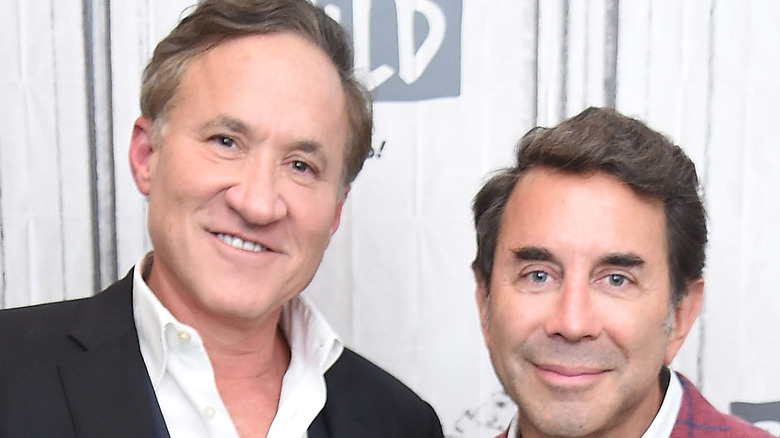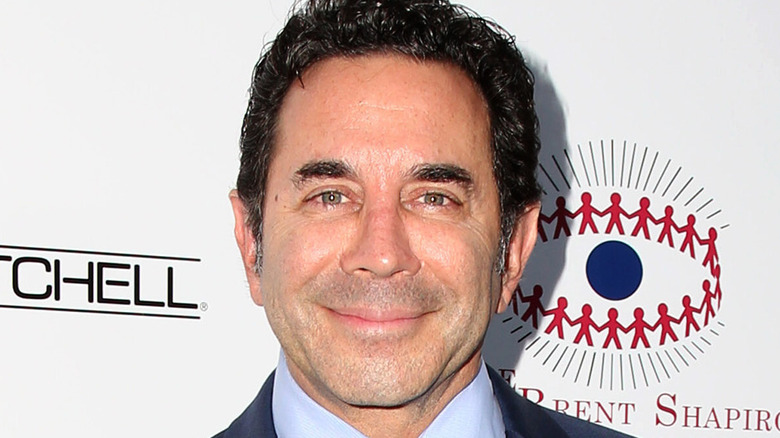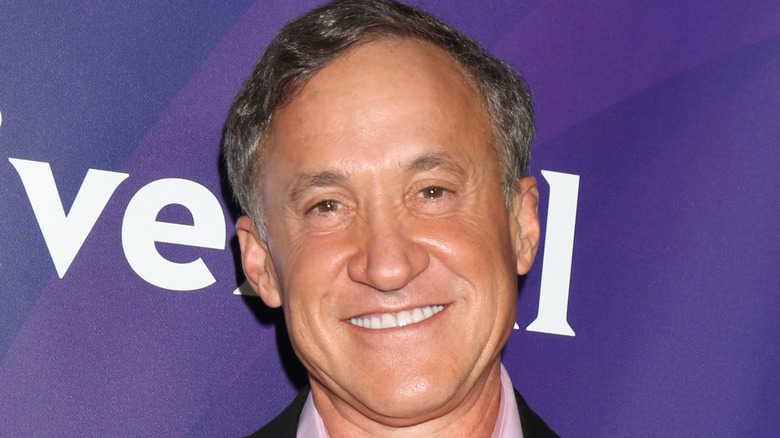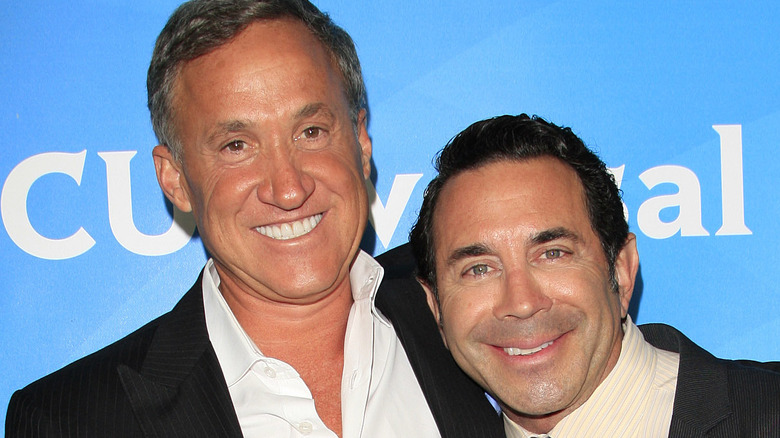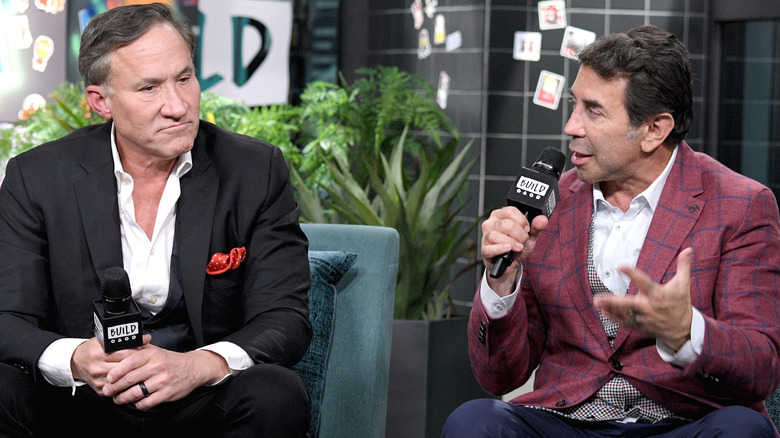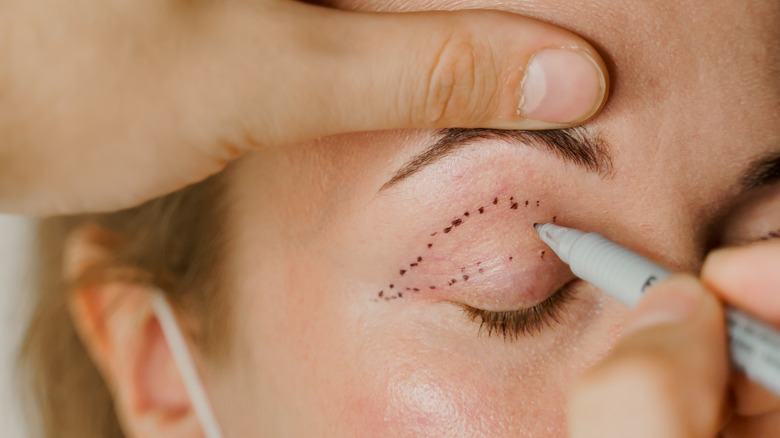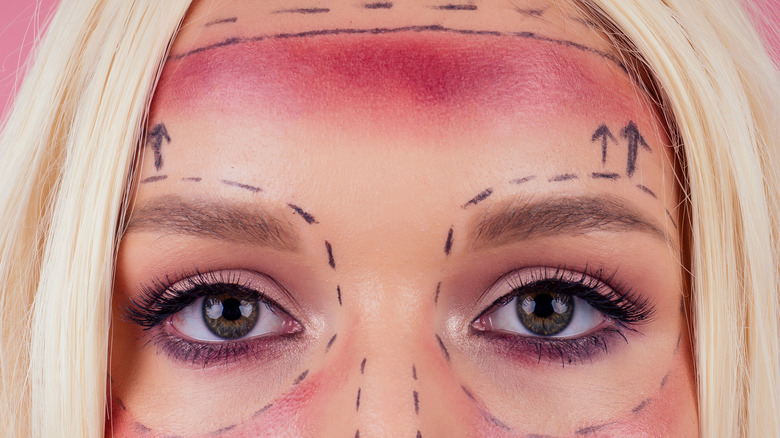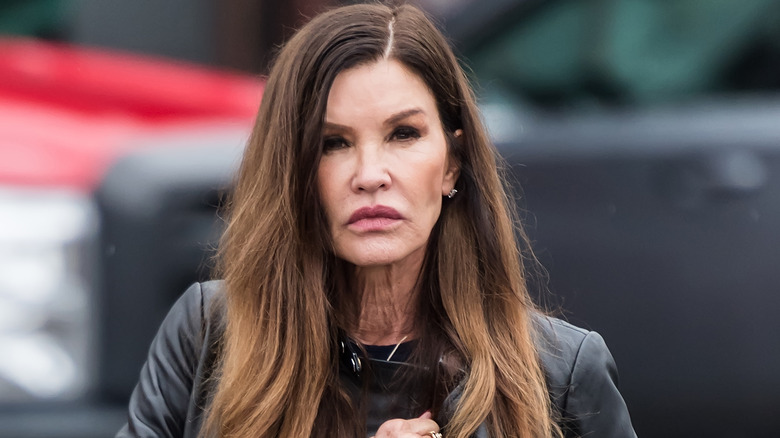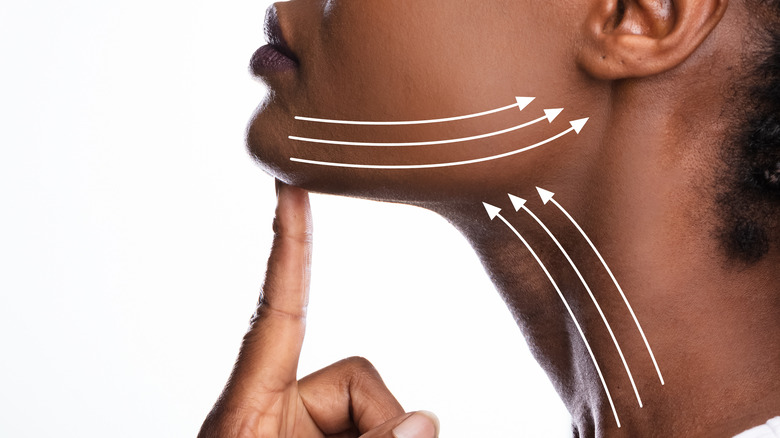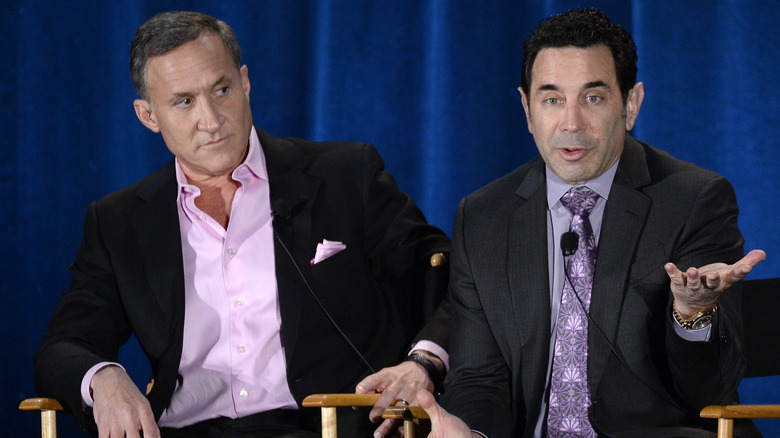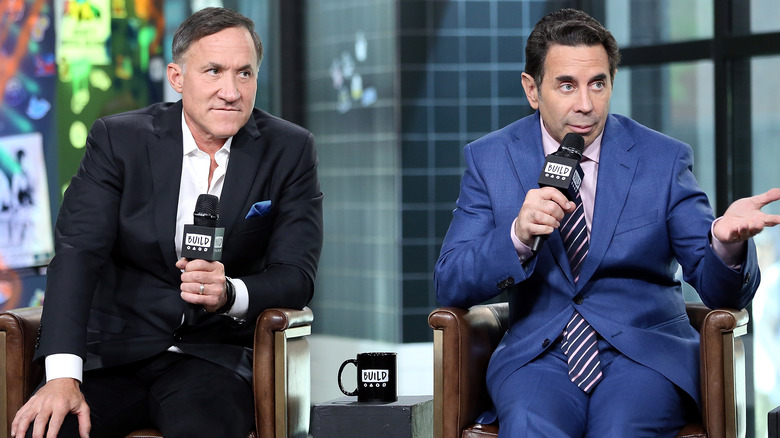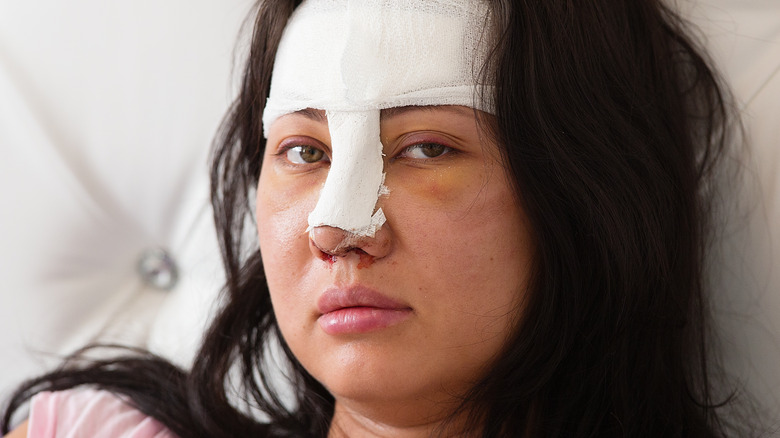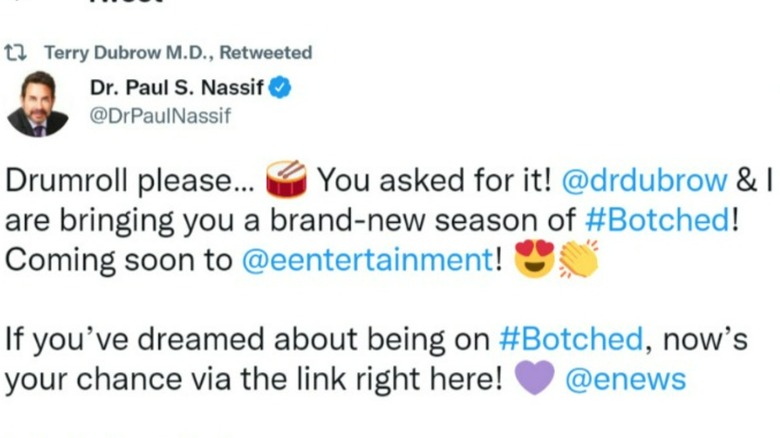What You Didn't Know About Botched
It started with a premise so juicy, you simply had to take a bite. It stars two uber-successful, uber-talented plastic surgeons, Drs. Paul Nassif and Terry Dubrow, both of whom have appeared as husbands on seasons of "Real Housewives." Both doctors honed a particular talent for correcting seemingly uncorrectable flaws and try to help patients whose previous plastic surgeries went horribly awry, leaving them so desperate and vulnerable that once you have them on your screen, you cannot look away.
We won't call it a "train wreck," however, because the end game isn't wreckage but self-acceptance, not to mention a savvier approach to health consumerism. We're talking, of course, about E!'s "Botched," which began airing in 2014, later spawning a sequel, "Botched By Nature," which has the doctors traveling cross-country to help people with physical flaws not caused by another surgeon's scalpel.
You'll see nose jobs and boob jobs aplenty on "Botched," but also shocking rib removals, butt implants, and lip augmentations. But while you might come for the "oh, the humanity" feels, you'll stay for the fact that Nassif and Dubrow are so compelling themselves — both as surgeons capable of accomplishing the seemingly impossible and as vulnerable and empathic humans for whom the quest for perfection is real and personal. In other words, to appreciate "Botched" in full, you really need to understand the backstory. Here's what you didn't know about "Botched."
Dr. Paul Nassif himself is a veteran of facial plastic surgery
Dr. Paul Nassif, who got his medical degree at USC in 1992 and who specializes in facial plastic surgery, is not just a plastic surgeon, but also a board-certified ENT-otolaryngologist (via U.S. News & World Report). This is highly desirable in facial plastic surgeons because they receive extensive training with regard to the internal workings of the nose. This comes in handy because they're spending most of their professional time concentrating and honing their work on faces (via ENT Orlando). But Nassif is also a veteran of facial plastic surgery, not to mention Botox and other injectables (via BravoTV).
Among other procedures, Nassif underwent a facelift in 2018, which was performed by Dr. Andrew Jacono, according to Page Six (via New York Facial Plastic Surgery Center). Dr. Jacono was "extremely flattered" that Dr. Nassif chose him, but it's not all that surprising since they've known one another for over two decades, and Jacono is renowned for his "deep plane facelift," which "works under the face of the muscles," according to Jacono, and it "doesn't tighten the surface, which is obviously very important for anybody, but especially for a man. If their face looks in any way tight, it makes the face look feminized."
Although the price for a deep plane facelift is about $50,000, there's a pretty decent chance that Dr. Nassif got a discount since Jacono typically extends a "professional courtesy to friends and family members."
Dr. Terry Dubrow isn't necessarily a personal fan of plastic surgery
Dr. Terry Dubrow has been performing plastic surgery in front of the cameras since 2004. That is when he was featured on the extreme plastic surgery makeover reality show, "The Swan" (via Dr. Dubrow). Although "The Swan" is known as one of the more "controversial and offensive" reality shows in history for its premise alone — that its patients were cast as "ugly ducklings" with "low self-esteem" before subjecting themselves to multiple surgical procedures to turn them into proud and beautiful "swans" (via Metro), the fact is that Dubrow is not personally a huge advocate of plastic surgery to cure self-esteem issues.
Dubrow's true passion is to achieve "invisible plastic surgery results," where "patients walk away looking and feeling more confident and more like themselves" (via Orange County Plastic Surgeons). He's even referred to plastic surgery as "barbaric" (via Too Fab). Moreover, he claims to have never gone under the knife, per se, for vanity purposes (via Bravo TV). Dubrow, has nevertheless, copped to making use of facial fillers such as Botox, according to Page Six. But he has since gone on the record to say that when it comes to fillers, "less is more."
The Botched docs are best buds with adorable friendship chemistry
Page Six once called Drs. Paul Nassif and Terry Dubrow's friendship, "the ultimate bromance." The unmistakable chemistry between these two has been nurtured over more than two decades of friendship.
The two met in 1999 when Nassif opened his practice in Beverly Hills, California. He was urged by his mother and sister to connect with Dubrow. "After meeting the mom and the sister, I thought I got to meet this guy. They're so nice," Dubrow is quoted as having said. "And then unfortunately you know it didn't cross the gender lines. The male wasn't that good." But clearly, as is evident from the Page Six interview in which the two banter regarding their history, these docs have a great rapport and a genuine affection for one another.
You can see it in the way they joke about Dubrow having overdone it with the fillers (via Page Six). And you can hear it in the way that Nassif talks about not hearing from Dubrow for a month and then getting a "text of him insulting me." Apparently, their rapport derives, in part, from their personalities being complimentary of one another. Dubrow is the "comedian," while Nassif is the "sensitive" one who is nevertheless sometimes misunderstood. "He treats you like you're his assistant," Dubrow pointed out, but apparently, only before he gets to know you.
Botched is flat-out premised on shock value, but it's not meant to be cruel
When Celebuzz asked how "Botched" came about, Dr. Paul Nassif, who had appeared on the first three seasons of "Real Housewives of Beverly Hills" while he was still married to his first wife, Adrienne Malouf, was happy to explain. Apparently, he had been brainstorming with the executive producers of the "Housewives" franchise regarding coming up with a premise for a "good plastic surgery show."
Nassif immediately thought of Dr. Terry Dubrow, with whom he had already been friends for many years. You might be surprised by this, though, considering they hadn't shared any "Housewives" screen time — and by the time "Botched" first aired, Nassif and Malouf had already undergone a public and rather "nasty" divorce (via People). Dubrow knew he was someone he could collaborate with to create a show that balanced equal helpings of empathy and shock value.
And how exactly does "Botched" manage to walk that line? For the most part, Nassif and Dubrow demonstrate what appears to be genuine empathy for the patients they take on. The "shock value" is observed primarily in connection with the patients that they end up turning down. "There's the life-changing really happy portion of ['Botched']," Nassif pointed out to Celebuzz, while at the same time, "it can also be a little bit tense and a little bit [sad]."
The Botched formula fails to resonate with some plastic surgeons
As much as the general public may adore "Botched” for its brilliant mix of shock value, pathos, and friendly ribbing between Drs. Dubrow and Nassif, there are, nevertheless, plastic surgeons out there who feel it falls flat. Dr. Samuel J. Lin, a plastic surgeon from Boston, Massachusetts, lumped the show in with "The Swan," "Extreme Makeover," and "Dr. 90210" (which the "Botched" doctors and exec producers alike would probably strongly disagree with doing). In an opinion piece for Boston magazine, Lin wrote, "Shows like Botched are bad for plastic surgery, and unfortunately can misguide the public."
First, according to Dr. Lin, the depiction of plastic surgery disasters could scare away potential plastic surgery patients, whose "fears and concerns of having plastic surgery are overwhelmingly confirmed with this show." Dr. Lin also noted that the show could be interpreted as implying that those who decide to get plastic surgery can get away with not doing their research — on the assumption that if they find themselves "botched," it will be readily fixable. And that would be irresponsible, according to Dr. Lin who advises that anyone considering plastic surgery make absolutely certain that the plastic surgeon being considered is board certified and has completed a full plastic surgery residency. Moreover, Dr. Lin objected to the "Wow, look at that person!" shock value that, in part, underlies the show's success.
How Botched differs from other plastic surgery reality television shows
When "Botched" first aired on E!, The Atlantic took some issue with it, calling it "ghastly" and "mean" and lumping it in with other "body-image exploitation shows," even while acknowledging that the series "tries to distinguish itself by showing some of the shadier practices of the cosmetic surgery industry."
Ultimately, however, The Atlantic concluded that "Botched" does, in fact, offer something of value to viewers because, among other things, it raises important questions not only about plastic surgery but also the dynamics that underlie the entire plastic surgery industry. For example, one thing "Botched" exposes is "a larger question of who gets held accountable when a surgeon's over-eagerness for profit results in a surgery disaster, or when patients, so distraught over their body image, find poorly regulated fillers to fix themselves up or demand the impossible and the risky from their own doctors."
In addition, The Atlantic pointed out that "Botched" makes it clear, over and over again, that plastic surgery is actual medical surgery that is not meant to be "a frivolous indulgence." For example, Drs. Dubrow and Nassif often make a point of chiding their patients — in front of the cameras — for having made what the doctors characterize as irresponsible decisions with their health (e.g., a woman admitted on camera that she had inserted her own black-market breast implants).
How are there enough botched plastic surgeries to continue supplying the series with patients?
Botched plastic surgeries are not exactly "common," per se, but they do happen on a somewhat regular basis, according to the medical professionals at Charlotte Plastic Surgery. One reason is due to the sheer number of cosmetic surgical procedures that are performed. In 2020, that number was well over 2 million — and that doesn't even account for medically-necessitated reconstructions, according to the American Society of Plastic Surgeons.
Given that the consequences of a botched plastic surgery are not necessarily merely "cosmetic" but may translate to chronic physical or emotional discomfort and serious health issues, one might even consider the two to three patients per "Botched" episode who are actually alive and healthy enough to consider undergoing revision surgery as the lucky ones.
Another reason for the ample supply of patients seeking revision surgery is the fact that the plastic surgery industry is, by definition, in the business of capitalizing on low self-esteem in vulnerable people (via Dr. Wilson Cosmetic Surgery). In addition, according to The Atlantic, the industry has enough shady practitioners to have earned a reputation for predatory behavior amongst its practitioners, in addition to general sloppiness. This, itself, is fueled by a lack of regulation of the "medical spas" where some botched surgeries take place and the fact that many cosmetic surgeons don't accept third-party payment (i.e., by insurance companies), with the result being that plastic surgeons end up being subject to less scrutiny than many other doctors.
How do Botched patients pay for their surgeries?
Plastic surgery is rarely covered by insurance (some exceptions include reconstructive or medically warranted surgeries), according to The Atlantic, and it inevitably costs a bundle. As of 2021, according to the medical professionals at Westlake Dermatology, the average price for one of the least-expensive plastic surgical procedures, lip augmentation, starts at over $2,500.
Chin augmentation can often cost double that. Same with eyelid surgery. The "higher-priced" (as if $2,000 weren't high) cosmetic surgeries include breast augmentation, breast reduction, liposuction, rhinoplasty (nose job), and tummy tucks, all of which tend to cost somewhere between $5,000 to 10,000 dollars. A full "body lift" can cost upwards of $15,000, and a facelift can cost over $12,000. That being said, these prices are likely not applicable to "celebrity" surgeons like "Botched" stars Dr. Nassif and Dr. Dubrow.
So then how do the "Botched" patients afford it? One reason why "Botched" is even possible, despite the steep cost of plastic surgery, is that its network, E!, pays every patient for appearing, according to Dr. Terry Dubrow (via Allure). That appearance fee is customarily used to pay some portion of the costs of the surgery.
Why so many celebrities have appeared on Botched
Many of the patients you'll see on "Botched" are "celebrities" of some kind or another. For example, OG supermodel Janice Dickinson was one of the first full-fledged celebrities to appear on the series (via IMDb). Dickinson appeared on the show to address her "outdated" breast implants. Former "Baywatch" babe Nicole Eggert turned to the famous doctors for a breast reduction (via Daily Mail). "Botched" also has its share of adult film stars and reality stars.
For example, there's Honey Boo Boo's Mama June, who appeared in Season 3 for a little work on her "fupa," and OG Teen Mom Farrah Abraham, appeared on the show, although her request for a "permanent" lip filler was denied (via Hollywood Life). And then there are the celebs who are famous for their plastic surgeries, such as Justin Jedlica, the "Human Ken Doll," who starred in the series premiere (via E! News).
How does a non-celebrity end up on Botched?
The producers of "Botched" cull their patients from among both celebrities and ordinary mortals. To appear on "Botched," you have to be 18 or older, according to the casting page. You also have to fill out an extensive application, noting your previous plastic surgeries and describing what you perceive as "botched." Then you have to back it up with photos. You also have to agree to quite a lot of legalese intended to protect the show and its producers from pesky litigation.
But there is a lot of competition. "In the first season, we had 500 applicants for casting," Dr. Terry Dubrow told Distractify. "By the time the show got known for the second, third, and beyond, we had around 10,000 applicants." And then there's this: Some of the people who end up on "Botched" are actually hand-selected by Dubrow and Dr. Paul Nassif from among their own patients.
"If a patient comes in and has a really unusual, difficult-to-fix, almost hopeless situation and I can tell that they don't necessarily have the resources or the funds to have the reconstruction, I'll say 'don't take this wrong or anything, but you might be able to get on the show if you're willing to show your journey to the world,'" Dubrow explained. And "nine times out of 10, they say that they'll do it."
Here is who you will never see on the show
With or without the intense competition among non-celebrities for the opportunity to have one's expensive plastic surgery partly funded via an appearance on "Botched," Drs. Terry Dubrow and Paul Nassif maintain certain standards about whom they are willing to take on as patients. First, they categorically will only accept adult patients (via Zwivel). This is for ethical reasons and notwithstanding that some plastic surgeries are "traditionally accepted as being okay for children" (such as surgeries to correct congenital deformities). In addition, the doctors turn down potential patients slash guests who have unrealistic expectations or who want something the doctors feel will ultimately "do them harm rather than good" (via Celebuzz).
Although Nassif told Celebuzz that viewers will definitely see their share of "crazy" on "Botched," the "crazy" tends to be in the form of either patients whom the doctors say "no" to about various surgeries or "surprising things you wouldn't expect in regards to shock value and what patients do when they go out and do things that's a little bit crazy, body modification or they want to look like certain celebrities."
What you won't see on "Botched," however, are the doctors agreeing to perform surgeries on patients with "psychological" issues or even physical issues that would make surgery a bad idea — despite that many other plastic surgeons might not say "no" to patients who have clearly "had enough," as Dr. Dubrow told Zwivel.
Why satisfaction cannot be guaranteed on Botched
One of the most difficult-to-navigate dynamics between the "Botched" doctors, on the one hand, and their patients, on the other, is that there is a fairly decent chance that even after surgery, a patient may still find themselves dissatisfied with their appearance. It's worth noting here that a good 65% of Dr. Paul Nassif's regular day-to-day practice consists of patients seeking revision surgery for previous nose job surgeries, as he told Celebuzz.
However, statistically speaking, it simply cannot be that all the doctors who performed those surgeries for which patients were dissatisfied were unskilled or irresponsible. In fact, overall, rhinoplasty (the medical term for a nose job) has a notoriously low rate of patient satisfaction, according to a 2015 study published in the Aesthetic Surgery Journal, and this is due, at least in part, to "potentially unrealistic patient expectations" — which happens to be pervasive among plastic surgery patients even when doctors do their best to eliminate those with the most unrealistic expectations.
Further, someone who has a history of multiple "failed" plastic surgery procedures may well be at higher risk for experiencing continuing "failure" in revision surgery, in part because those who have sought out multiple plastic surgeries may be at a higher risk for body dysmorphic disorder, which, itself, is a risk factor for "failures" or, more accurately, "perceived failures," as pointed out in a 2004 study published in the journal of Plastic And Reconstructive Surgery.
You often can't and won't see a Botched patient's entire journey
Another hard fact that patients appearing on "Botched" must face — even if it's not readily apparent to casual viewers of the show — is that revising previous plastic surgeries may well require more than one revision surgery in order to achieve anything close to the desired results. "We warn the patients on Botched, [saying] 'I may send you down a road that will botch you, but in order to get you un-botched, I may have to make you worse before I can make you better,'" Dr. Terry Dubrow said (via Distractify). "The journey sometimes needs two or three more surgeries," he added.
Dubrow likened the situation to that of a patient with a physical illness, with respect to which the treatment makes the patient sick before the patient gets better. However, outside of the plastic surgery realm, this reality is well-understood (even if not well-liked by patients). For example, chemotherapy can make a cancer patient both feel and look sicker before the patient makes it into remission, according to Healthline. In fact, chemotherapy can actually sicken a patient even as it is helping eradicate the cancer. However, what may end up being a long journey to a successful plastic surgery outcome can seldom be depicted in a single episode. And this, in itself, only further contributes to the already-existing unrealistic expectations that the general public may have about what plastic surgery can actually accomplish.
What are the most requested procedures for the 'Botched' docs?
"Botched" Season 7B premiered in January 2022 (via SportsKeeda). We'd barely finished emotionally processing all the associated feels when we learned Season 8 had been greenlit (per Variety). In fact, a pair of tweets by Drs. Dubrow and Nassif suggest that casting is underway — and has been since late July. That, of course, begs the question: What sort of procedures will the doctors take on in Season 8?
No word as yet, but it's safe to assume that the procedures we'll see will be along the lines of what we've seen in prior seasons, which is to say we expect there'll be quite a few one-of-a-kind emotionally challenging situations. For example, Season 7B included a procedure in which a woman's lip was reconstructed after a botched cancer surgery.
What's more easily predictable is what the "Botched" doctors' non-televised patients will be signing up for — because those tend to follow the trends. For example, halfway through 2020, the Kardashian butt was on everyone's wish list, according to Dr. Dubrow (via Channel News24), and today, the Kardashians are still the definition of "influencer." That being said, the most requested plastic surgery procedures in 2022 will probably not be all that different from the most popular of 2021. Per the Aesthetics Society, facelifts, breast procedures, and liposuction led the charge, with facelifts increasing 54% since 2020, breast procedures up 48%, and liposuction up 63% (via PR Newswire).
The Botched doctors' advice for finding a plastic surgeon
In 2016, the Pew Research Center ascertained that few Americans have had plastic surgery. Nevertheless, according to the world's largest association of facial plastic surgeons, the American Academy of Facial Plastic and Reconstructive Surgery, plastic surgery grew by leaps and bounds following the lock-down phase of the COVID-19 pandemic. The year 2021 saw 1.4 million plastic surgery procedures (both surgical and nonsurgical); on average, every plastic surgeon performed 600 more procedures than they did in 2020 (a 40% increase).
That's great if people wish to exert agency over their appearance and have the financial and emotional wherewithal to see it through. The only wrinkle we see is this: who is performing all those plastic surgery procedures? If there's one thing we've learned watching "Botched," it's the importance of doing everything in your power to select the right surgeon before going under the knife.
Dr. Nassif recommends finding a surgeon who is board certified in the type of surgery you're having (via Page Six). Dr. Dubrow adds that your surgeon should have privileges at a reputable hospital. Ideally, your plastic surgeon will have extensive experience in whatever procedure you're interested in having. And not just ordinary cases either, but rather, plenty of hard cases. Even better if the doctor you select isn't a newly minted surgeon. And if you have to make a choice, Nassif and Dubrow suggest looking for someone with at least a few years of experience.
How much do these plastic surgeries cost?
Although plastic surgery is rarely covered by insurance (via The Atlantic), "Botched" patients receive a fee for appearing on the show, which they can put toward the cost of surgery (via Allure). But it's hard to imagine their appearance fees could ever cover all their costs. Plastic surgery is pricey, per the medical professionals at Westlake Dermatology, with standard surgeries — the ones that are performed by plastic surgeons as a matter of routine — ranging in price from roughly $2,500 to over $15,000. A full-on "mommy makeover" could cost upwards of $20,000, per CareCredit.
But the patients who appear on "Botched" tend to present with cases that are quite a bit more complicated than what might be considered routine for the general population of plastic surgeons. Most, if not all, will involve some sort of revision surgery, which bumps up the price (as well as the difficulty of the case), according to CareCredit. Indeed, Dr. Dubrow told Cheat Sheet that the "extraordinarily difficult" type of surgery he and Dr. Nassif perform can cost in the vicinity of anywhere from $30,000 to upwards of $90,000 to $100,000. The high price rag reflects, among other things, the high level of risk associated with procedures involving more than one body part or scar tissue from previous surgeries, plus the sheer amount of time involved in the operating room (with surgeries involving as many as 16 or more surgeon hours not being unheard of).

